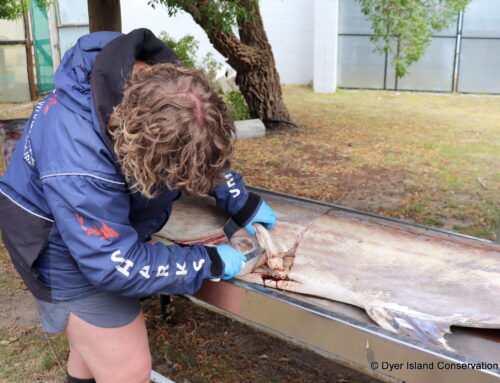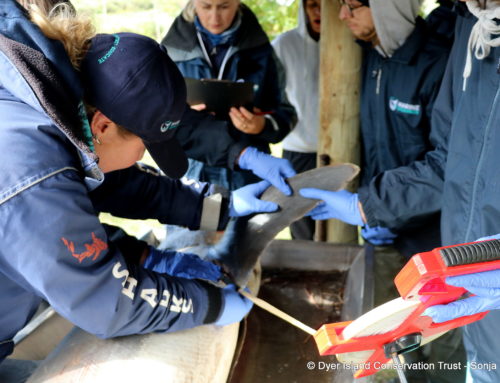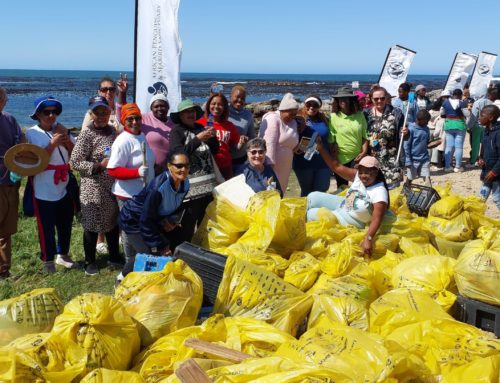COLLECTION OF SEAL SCAT ON GEYSER ROCK
December 31, 2008 by dyertrust
 On the 31st October 2008, Steve Kirkman (of Marine and Coastal Management) and Wilfred Chivell (founder of DICT) visited Geyser Rock to collect seal scat samples for an ongoing diet monitoring study. Collecting the scats found on the surface of the colony is preferable to shooting seals or immobilizing them and flushing their stomachs to obtain diet samples, methods which were used commonly on seals in the past. Sampling of scats is also much quicker and cheaper than the other approaches. Information on prey composition in the seal diet can be obtained from undigested prey remains which are often found in scats, such as fish otoliths, squid beaks, bird feathers and pieces of crustacean carapaces. Also, by taking measurements of otoliths and squid beaks, size estimates of individual prey can be obtained.
On the 31st October 2008, Steve Kirkman (of Marine and Coastal Management) and Wilfred Chivell (founder of DICT) visited Geyser Rock to collect seal scat samples for an ongoing diet monitoring study. Collecting the scats found on the surface of the colony is preferable to shooting seals or immobilizing them and flushing their stomachs to obtain diet samples, methods which were used commonly on seals in the past. Sampling of scats is also much quicker and cheaper than the other approaches. Information on prey composition in the seal diet can be obtained from undigested prey remains which are often found in scats, such as fish otoliths, squid beaks, bird feathers and pieces of crustacean carapaces. Also, by taking measurements of otoliths and squid beaks, size estimates of individual prey can be obtained.
 Seal diet, especially if monitored in the long term, can potentially provide a plethora of useful information for scientists and managers. Cape fur seals, as generalist feeders and top predators in the ecosystem, are expected to reflect the relative availability of different prey species in their diet. As such, their diet may provide an indicator of ecosystem changes over time, which may be caused by global climate change or over-fishing, which affect organisms lower down the food chain.
Seal diet, especially if monitored in the long term, can potentially provide a plethora of useful information for scientists and managers. Cape fur seals, as generalist feeders and top predators in the ecosystem, are expected to reflect the relative availability of different prey species in their diet. As such, their diet may provide an indicator of ecosystem changes over time, which may be caused by global climate change or over-fishing, which affect organisms lower down the food chain.
Information from Cape fur seal scats is also useful for investigating dietary interactions between the seals and their competitors, which includes commercial fishing fleets (e.g. the pelagic purse seine fleet) as well seabird species such as the African penguin, which is “threatened” in terms of its conservation status. Feathers in the scats at Geyser Rock also provide an indicator of the prevalence of seal predation on penguins and cormorant species breeding on neighboring Dyer Island, which has been identified as a conservation concern.
 Currently, assessment is also underway to determine whether quantitative information useful for the management of South Africa’s most lucrative fishery – hake, can be obtained from the scats, including those collected at Geyser Rock. Using measurements of hake otoliths retrieved from seal scats over time, it may be possible to estimate the timing of hatching of hake cohorts. Such information is important input for stock assessment models which are used to estimate annual total allowable catches.
Currently, assessment is also underway to determine whether quantitative information useful for the management of South Africa’s most lucrative fishery – hake, can be obtained from the scats, including those collected at Geyser Rock. Using measurements of hake otoliths retrieved from seal scats over time, it may be possible to estimate the timing of hatching of hake cohorts. Such information is important input for stock assessment models which are used to estimate annual total allowable catches.
Further research on the seals at Geyser Rock is projected for 2009. This will entail placing satellite transmitters on a sample of seals at the island, so that their at-sea movements can be monitored. The sample will include some juvenile seals because previous satellite telemetry studies on the Cape fur seal have been based only on older seals and information regarding the movements of juveniles is lacking, even though the performance of this life stage is critical to the population dynamics of marine mammal populations. In particular, the movements of juvenile seals shall be used to assess their interactions with their environment, including prey, predators and human activities (fishing). This study shall get underway in May/June 2009.









